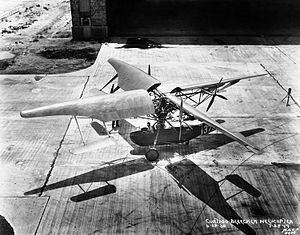First flight 1926 | ||
 | ||
Manufacturer | ||
The Curtiss-Bleecker Helicopter was an American prototype rotary wing aircraft, introduced in 1926. The thrust of the aircraft was distributed from a central mounted engine through shafts to propellers mounted on each rotor blade.
Contents
Design and development
The Bleecker Helicopter was designed by Maitland B. Bleecker, a junior engineer from the National Advisory Committee for Aeronautics. The aircraft was constructed by Curtiss Wright for $250,000 over the course of four years at Garden City.
The aircraft featured a rotary wing design with a single engine. Each rotor, painted silver and yellow, had an individual propeller for thrust and a trailing control surface called a "stabovator" to change pitch of the rotor. The aircraft was controlled by a stick that operated like a modern helicopter collective control. Yaw was controlled with a "Spin Vane" that used downwash from the rotor to pivot the aircraft with foot pedals.
Operational history
Testing on the Bleecker Helicopter was stopped after the failure of a drive shaft on a test flight in 1929. By 1933 the project was abandoned following vibrational issues in further tests.
Specifications
Data from NASA
General characteristics
Performance
